Troy reporting in: Made it to the UK sometime either today or yesterday.. not really sure what time means anymore. More photos to come as I get the chance to look them over and upload.
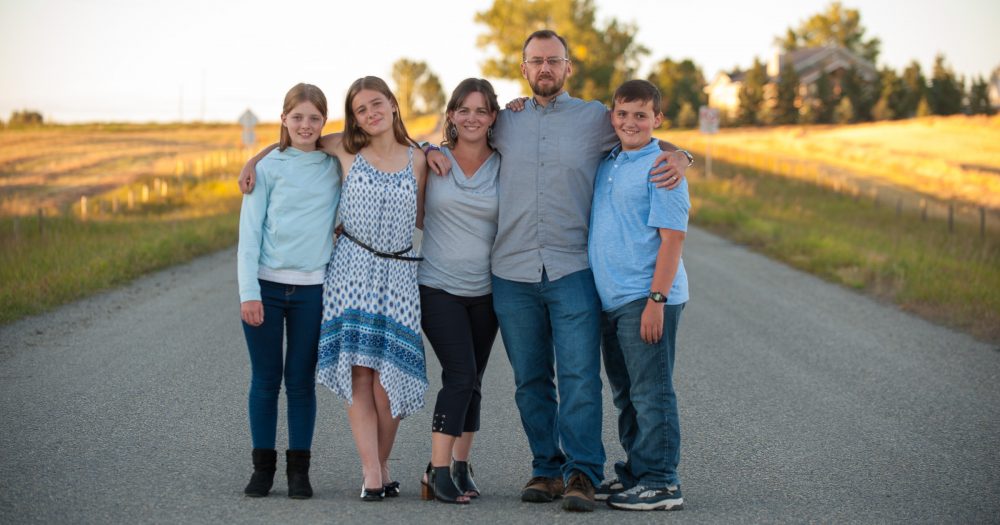
Troy reporting in: Made it to the UK sometime either today or yesterday.. not really sure what time means anymore. More photos to come as I get the chance to look them over and upload.
Photography is like any art form, the art is independent of the tools used, the art comes from the artist (see Your Camera Doesn’t Matter). But a nice instrument sure makes it easier to get the results you want. Naomi has a nice violin that was given to her years ago, but if I pick it up it sounds terrible. She, however, can make beautiful music on it. But I digress..
Over the last 7 years that I have been doing photography my pictures and cameras that I use have improved. Here is a flashback to shutters of yore..
My first camera that I used for serious photography was a 1978 Pentax ME F. I dug it out of the closet back in 2000 and continued to use it for four years. This was a great camera for me to learn the technical side of photography on as everything was manual. No autofocus or easy exposure settings for this beginner. The camera was pretty basic with it’s manual focus, manual aperture priority (you turned a ring on the lens to adjust the exposure to the desired exposure setting), confusing flash settings (a couple of sliders on the back of the flash that had to be set to match distance and ISO of your film), and hand winding of the film. With my main lens that I used you would have to adjust three rings on it: focus, zoom and aperture, meaning that quick action shots were difficult to get.
While it was good to learn on, it was, however, expensive to operate. I always knew that to press the shutter button was another 25 cents, so I didn’t frivolously take pictures. I had to consider each shot more carefully back then, and always in the back of my mind was the questions: “Is it worth taking another shot of this? Will I be able to get a better picture? Probably not. One shot will have to do.” This tended to keep me from experimenting much with my photography.
Using this camera was also an exercise in delayed gratification and disappointment. There were times when I could fill two rolls in a day, but most of the time I would only shoot one roll every week or two. Then it was a few days to get prints back, and I could never remember what my settings were that worked or didn’t work for a picture. Back then, I used to be happy if I had one or two pictures out of a roll that I liked.
Dad used to have two of these cameras but one went missing during a family reunion years ago. He had set it down somewhere to join a game of baseball and then forgot about it when he went off to do something else. He realized it was missing once everyone else had left so we all went outside to look for it, but the search was in vain. It did turn up again several months later. One Fall morning after a particularly windy night that had blown off most of the leaves, I was eating breakfast by the window and looking out at the now naked trees.
“Hey dad, what is that black thing in the tree?”
“Oh no.. I think it is my camera…”
Cameras don’t usually work well after four months in a tree.
Nikon D70
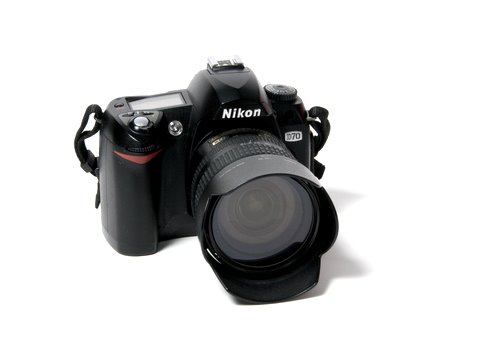
After using some point-and-shoot digital cameras I swore I would not go digital until I could get an SLR. But this was back in 2003-4 and the basic digital cameras were really limited and slow. Anyway, the Lord unexpectedly provided the funds for a new camera in spring 2004 and I purchased a Nikon D70. Finally, a modern camera, and a digital one at that! I was so excited that I hardly slept for two whole days. The sign of a serious geek.
I finally had a camera that would do some of the technical thinking for me and allow me to concentrate on the subject and composition .. Auto focus is way better than sliced bread. With a digital camera I could also experiment a lot more, take shots without worrying of the expense and see the results right away. I had to learn to use it fast because four days after I got it I had the first of many photo shoots for Word of Life promotional photography. Within 6 weeks I had taken my first 5000 photos on this camera and I could really see serious improvement in my photography skills.
Unfortunately, this was a very early production camera, one of the first off the line and it gave me some problems. Like when it died shortly after Ellie was born.. Imagine the predicament of an aspiring photographer being without a camera at such an important time! Out came the Pentax while the Nikon went into the shop to fix a problem most early versions had. After a few years it developed some other problems where it would randomly turn itself off repeatedly. This continued to get worse through the Fall of 2007 until we decided to replace it as it was sometimes almost unusable. Gone are the days when a good camera body will likely last 20+ years (unless you leave it in a tree, of course). But after 45,000+ photos, it has been a very good camera.
Nikon D300

Purchased in January, 2008, the Nikon D300 has been a joy to use. A much more professional and advanced camera than the D70, it has many new features that I have been using to improve my photography. I think I have taken some of my best pictures in the last few months with this camera. With its higher resolution, an image stabilization lens, greatly improved image noise reduction (great for shots of the night sky), auto ISO adjustments, etc etc, I have much more flexibility that has enabled me to get some shots I know I would have missed or not been happy with before. I have already used this camera quite a bit to do some stock photography for GoodSeed and had lots of fun using it outdoors capturing the beauty of nature or quirky moments with the kids.
You can check out some of my new shots that I have taken on the D300 at: www.troyandnaomi.com/photography/recent/
Since I arrived in Alberta I have been waiting for the opportunity to photograph the Aurora Borealis. I have been wanting to try and photograph them for years, but we are still a few years from solar max, so the night sky has been pretty quiet.
I had signed up for auroral activity email alerts to let me know when they may be visible and it paid off. Friday night at about 11:00 PM I checked my email and saw the possibility of aurora so I checked some space weather sites (Canadian Space Weather www.spaceweather.gc.ca/forecastmap_e.php and www.spaceweather.com) and saw that the sky show was on!
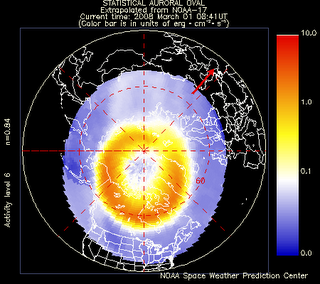
(the auroral activity ring that night)
I quickly packed up my tripod, camera, some warm clothes and headed off to a friends farm. I knew he was a poor shot so I would be safe walking around behind his house. I spent a couple hours out getting pictures from different locations. That time of night it is very quiet except for the distant howling of the coyotes.
Usually I was taking 30 second exposures and the camera would do a noise reduction for another 30 seconds. So I had a lot of very quiet minutes to just watch and contemplate God’s beautiful creation and thank him for the opportunity to witness it.
After awhile the auroral display started to calm down to just a dim green glow so I packed it in and was home around 2:30 AM. Late night, but definitely worth staying out.
If you would like to see more of my photography of the night sky and Northern Lights, go to my Astrophotography gallery
On the evening of February 20 we had a clear sky for the Lunar Eclipse. I haven’t seen one in years as the last two I had opportunity to watch were clouded out, so this was a real treat. I was able to set up the telescope and camera to watch the event.
A lunar eclipse is what happens when the Moon passes into the Earth’s shadow. When that happens the Moon often turns red. If you were to stand on the surface of the moon during an eclipse and looked at the Earth, you would see a black disk (the Earth) surrounded by a ring of red. The red is the light from the sun passing through the atmosphere. The only light hitting the moon is the combined light of all the Earth’s sunrises and sunsets.
Here are some of my photos as the moon disappears, is at totality (completely in Earth’s shadow), and as it leaves the shadow.
Phases and thoughts of our earthly companion, the Moon.
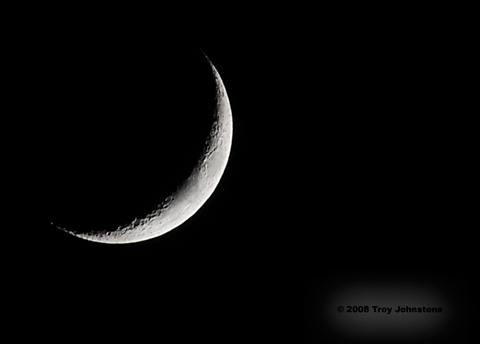
[large] 1/13 sec, 300 mm, f11 on a Nikon D300
God made two great lights—the greater light to govern the day and the lesser light to govern the night. He also made the stars.
– Genesis 1:16
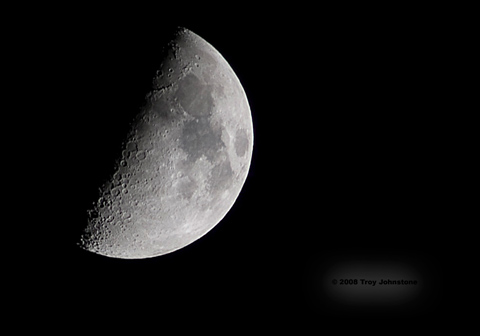
[large] 1/125 sec, 300 mm, f5.6 on a Nikon D300
The sun has one kind of splendor, the moon another and the stars another; and star differs from star in splendor.
– 1 Corinthians 15:41
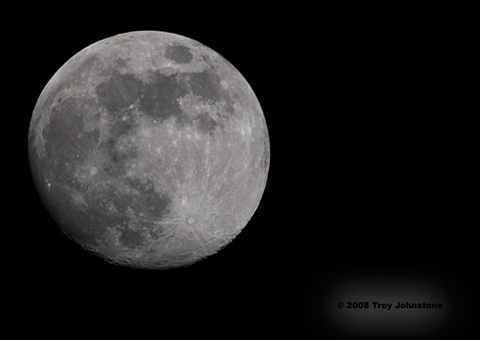
[large] 1/200 sec at 300mm f7.1 on a D300
Give thanks to the LORD, for he is good.
His love endures forever.
Give thanks to the God of gods.
His love endures forever.
Give thanks to the Lord of lords:
His love endures forever.
to him who alone does great wonders,
His love endures forever.
who by his understanding made the heavens,
His love endures forever.
who spread out the earth upon the waters,
His love endures forever.
who made the great lights—
His love endures forever.
the sun to govern the day,
His love endures forever.
the moon and stars to govern the night;
His love endures forever.
– Psalm 136:1-9